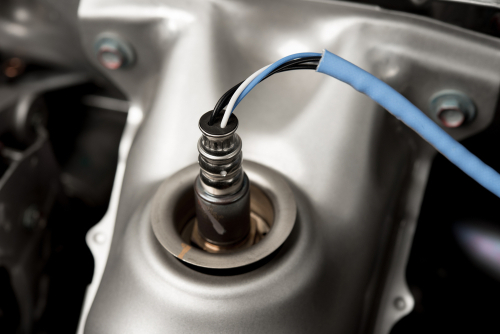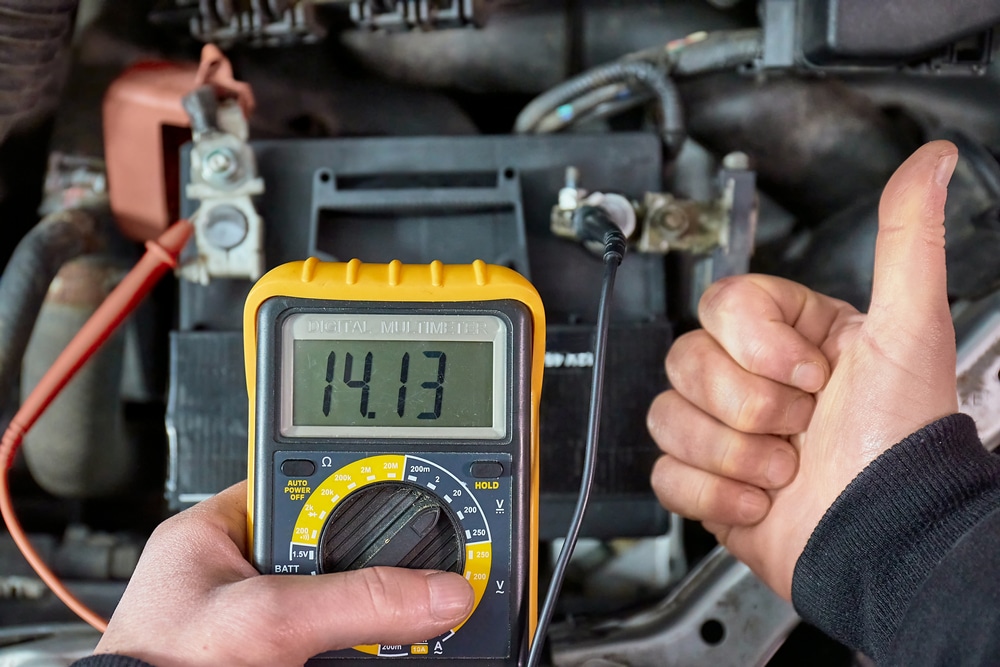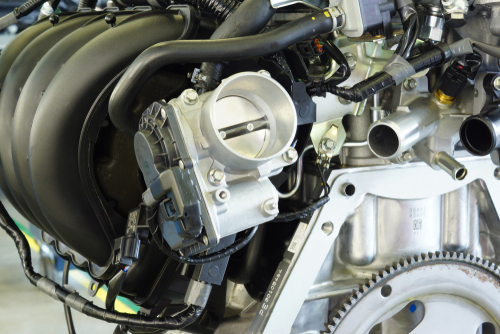Ever had your Check Engine Light illuminate unexpectedly? It might be the P0036 code throwing a wrench in your day.
This pesky little code relates to the HO2S Heater Control Circuit (Bank 1 Sensor 2), which is a mouthful, isn’t it?

The P0036 code indicates a problem with the oxygen sensor heater circuit after your catalytic converter. This sensor plays a crucial role in monitoring your exhaust gases and keeping your engine running smoothly.
When it’s not working properly, your vehicle’s performance and fuel efficiency can take a hit.
Think of it like a finicky thermometer for your car’s exhaust. When it can’t get an accurate reading, your engine’s computer doesn’t know how to adjust the fuel mixture.
The result? A less efficient ride and potentially more pollutants coming out of your tailpipe.
But don’t worry, we’ll break it down for you.

The P0036 code indicates a problem with the oxygen sensor heater circuit after your catalytic converter. This sensor plays a crucial role in monitoring your exhaust gases and keeping your engine running smoothly.
When it’s not working properly, your vehicle’s performance and fuel efficiency can take a hit.
Think of it like a finicky thermometer for your car’s exhaust. When it can’t get an accurate reading, your engine’s computer doesn’t know how to adjust the fuel mixture.
The result? A less efficient ride and potentially more pollutants coming out of your tailpipe.
But don’t worry, we’ll break it down for you.
Key Takeaways
- P0036 signals an issue with your vehicle’s oxygen sensor heater circuit
- This code can affect engine performance and fuel efficiency
- Proper diagnosis and timely repairs can prevent more serious problems
Understanding the Basics
The P0036 code relates to your car’s oxygen sensors, which play a crucial role in managing emissions and engine performance.
These little gadgets are like the nose of your car, sniffing out exhaust fumes to keep things running smoothly.
Role of Oxygen Sensors in Emissions
You might not think about them much, but oxygen sensors are the unsung heroes of your car’s emission control system. They’re constantly on the job, measuring the amount of oxygen in your exhaust.
Think of them as tiny chemists, analyzing the exhaust cocktail and reporting back to your car’s computer.
This information helps your engine adjust its fuel mixture, keeping it just right – not too rich, not too lean.
Your heated oxygen sensor (HO2S) works even harder.
It’s got a built-in heater that helps it warm up faster, so it can start doing its job sooner. This quick start is key for reducing cold-start emissions when your engine is most likely to be a bit of a polluter.
The sensor we’re talking about with P0036 is located after your catalytic converter. It’s like a quality control inspector, making sure your cat is doing its job of scrubbing those nasty emissions.
Decoding P0036

The P0036 code can be a bit of a head-scratcher, but don’t worry – we’ll break it down for you.
This pesky little trouble code is all about your car’s oxygen sensor heater circuit, specifically on Bank 1, Sensor 2. Let’s dive into what that actually means for your ride.
The Significance of Bank 1 Sensor 2
Bank 1 Sensor 2 might sound like a secret agent’s codename, but it’s actually pretty straightforward. Bank 1 refers to the side of the engine with cylinder #1. Sensor 2? That’s your downstream oxygen sensor, hanging out after the catalytic converter.
This little gadget is crucial for keeping tabs on your catalytic converter’s performance. It’s like a backstage pass to your exhaust system’s party. Without it, your Engine Control Module (ECM) would be flying blind when it comes to emissions control.
Interpreting the Heater Control Circuit
Now, let’s talk about that heater control circuit.
Your oxygen sensor needs to be hot to tango – about 600°F to be precise.
That’s where the heater comes in. It’s like a tiny sauna for your sensor, getting it up to operating temperature faster than your morning coffee.
When the PCM detects an issue with this heater circuit, it throws the P0036 code.
It’s basically your car’s way of saying, “Hey, the sensor’s not getting hot enough to work properly!” This can lead to poor fuel economy, higher emissions, and even damage to your catalytic converter if left unchecked.
Remember, a warm sensor is a happy sensor. Keep an eye out for this code to ensure your oxygen sensor is always ready to do its job.
Troubleshooting Steps for P0036

When your trusty ride throws a P0036 code at you, don’t panic! Let’s walk through some straightforward steps to get your oxygen sensor heater circuit back in shape.
Remember, a little elbow grease and patience can save you a trip to the mechanic.
Initial Inspection
Start with the basics, folks. Pop that hood and give your engine a good once-over.
Look for any visible damage to the wiring harness or connectors near the oxygen sensor.
Spot any frayed wires or loose connections? That’s your first clue.
Don’t forget to check for signs of rodent damage. Those little critters love to snack on wires!
While you’re at it, give the oxygen sensor a wiggle. If it’s loose, you might have found your culprit.
Lastly, inspect the sensor itself. If it’s covered in oil or coolant, you might have a bigger problem on your hands. Time to put on your detective hat!
Testing Resistance and Continuity
Now, let’s get a bit more technical. Grab your trusty multimeter – it’s about to become your best friend.
First, disconnect the oxygen sensor connector. Set your multimeter to ohms and test the resistance between the heater pins on the sensor side.
You’re looking for a reading between 5-40 ohms. If it’s out of this range, your sensor might be taking an early retirement.
Next, check for continuity between the sensor connector and the ECU. No continuity? You’ve got a break in the wire somewhere.
Don’t forget to test the ground connection too. A bad ground can throw off your whole system.
If all these tests check out, you might need to take a closer look at your ECU. But hey, at least you’ve narrowed it down!
Common Causes and Solutions
The P0036 code often stems from electrical issues in the oxygen sensor heater circuit. Let’s explore the main culprit and how you can tackle it head-on.
Investigating the Power Supply
First things first, you’ll want to check that blown fuse.
It’s like the bouncer at a club – if it’s not working, nothing’s getting in. Pop open your fuse box and look for the one labeled “O2 HEATER” or something similar.
If the fuse looks fine, don’t pat yourself on the back just yet.
Grab your trusty multimeter and check the power supply circuit.
You’re looking for 12 volts when the key’s in the “ON” position. No voltage? You might have a wiring issue on your hands.
Speaking of wiring, take a gander at that O2 sensor connector. Look for any signs of corrosion, melting, or damage.
It’s like checking your phone charger when it stops working – sometimes the problem’s right there in plain sight.
Don’t forget about the ground wire. A bad ground can cause all sorts of electrical gremlins. Make sure it’s clean, tight, and corrosion-free.
If all else fails, you might be dealing with a faulty O2 sensor.
These little guys work hard and sometimes just give up the ghost. Replacing it might be your ticket to clearing that pesky P0036 code and getting your fuel efficiency back on track.
Preventive Maintenance and Tips
Keep your engine purring like a kitten with these handy tricks. You’ll save yourself a headache and maybe even some cash at the pump.
Keeping Your O2 Sensors Happy
First things first, give your oxygen sensors a little TLC.
Check ’em regularly, especially if your car’s getting up there in miles. A clean sensor is a happy sensor!
Got a rough idle or your fuel consumption’s through the roof? Your O2 sensor might be throwing a fit.
Don’t ignore those warning signs, folks.
When it’s time for a replacement, don’t cheap out. High-quality parts are your best friend here.
They’ll keep your air/fuel ratio in check and your exhaust gases clean as a whistle.
Remember, a healthy O2 sensor means you’ll breeze through that pesky emissions test. Your wallet (and Mother Nature) will thank you.
Lastly, keep an eye on your ECU.
If it’s flashing that dreaded P0036 code, don’t panic.
A little maintenance goes a long way in keeping your ride smooth and your engine happy.
Frequently Asked Questions
Tackling P0036 issues involves pinpointing the HO2S location, following repair steps, and understanding brand-specific nuances. Let’s dive into some common queries about this pesky code.
How can I spot the precise location of the HO2S Heater Control Circuit for Bank 1 Sensor 2 in my vehicle?
You’ll find this oxygen sensor downstream of your catalytic converter on the exhaust system.
It’s typically on the engine side with cylinder #1, but consult your vehicle’s manual for the exact spot.
Don’t confuse it with Sensor 1, which sits before the catalytic converter. Look for a wired sensor screwed into the exhaust pipe – that’s your culprit!
What steps are involved in fixing an HO2S Heater Control Circuit issue in Bank 1 Sensor 2?
First, grab your trusty multimeter and check the sensor’s resistance. If it’s out of whack, you’re looking at a replacement job.
Next, inspect the wiring harness for any signs of damage or corrosion. Sometimes, a little electrical tape can save you big bucks!
Lastly, if all else fails, it’s time to swap out that sensor. Just remember to use anti-seize compound on the threads – future you will thank present you.
Are there any notable differences in addressing a P0036 code for Toyota vehicles compared to other brands?
Toyota’s vehicles often have tighter spaces around the sensor, making replacement a bit trickier.
You might need a special Toyota-specific oxygen sensor socket to get the job done. Don’t try to wing it with regular tools – you’ll just end up with bloody knuckles and colorful language.
Could you shed some light on the cost implications of repairing the HO2S Heater Control Circuit Bank 1 Sensor 2?
Brace yourself – your wallet might feel a bit lighter after this repair. The sensor itself can run you anywhere from $50 to $250, depending on your vehicle’s make and model.
If you’re handy with a wrench, you can save on labor costs. But if you’re all thumbs, expect to shell out another $100 to $200 for a mechanic to do the dirty work.
What usual suspects can cause the heater control circuit (Bank 1 Sensor 2) to malfunction?
The most common culprit is a faulty oxygen sensor. These little guys work hard and eventually wear out.
Corroded wiring or loose connections can also trigger the code. Don’t forget about blown fuses or a misbehaving PCM – they’re less common but still worth checking.
How do I differentiate between Bank 1 Sensor 2 and Bank 1 Sensor 1 when dealing with heater control circuits?
Think of it like a game of “before and after.”
Sensor 1 is the pre-game show, sitting before the catalytic converter. Sensor 2 is the after-party, hanging out downstream.
Bank 1 refers to the side of the engine with cylinder #1.
So, if you’re looking at Bank 1 Sensor 2, you’re on the right side (usually) and after the catalytic converter. Easy peasy, lemon squeezy!
